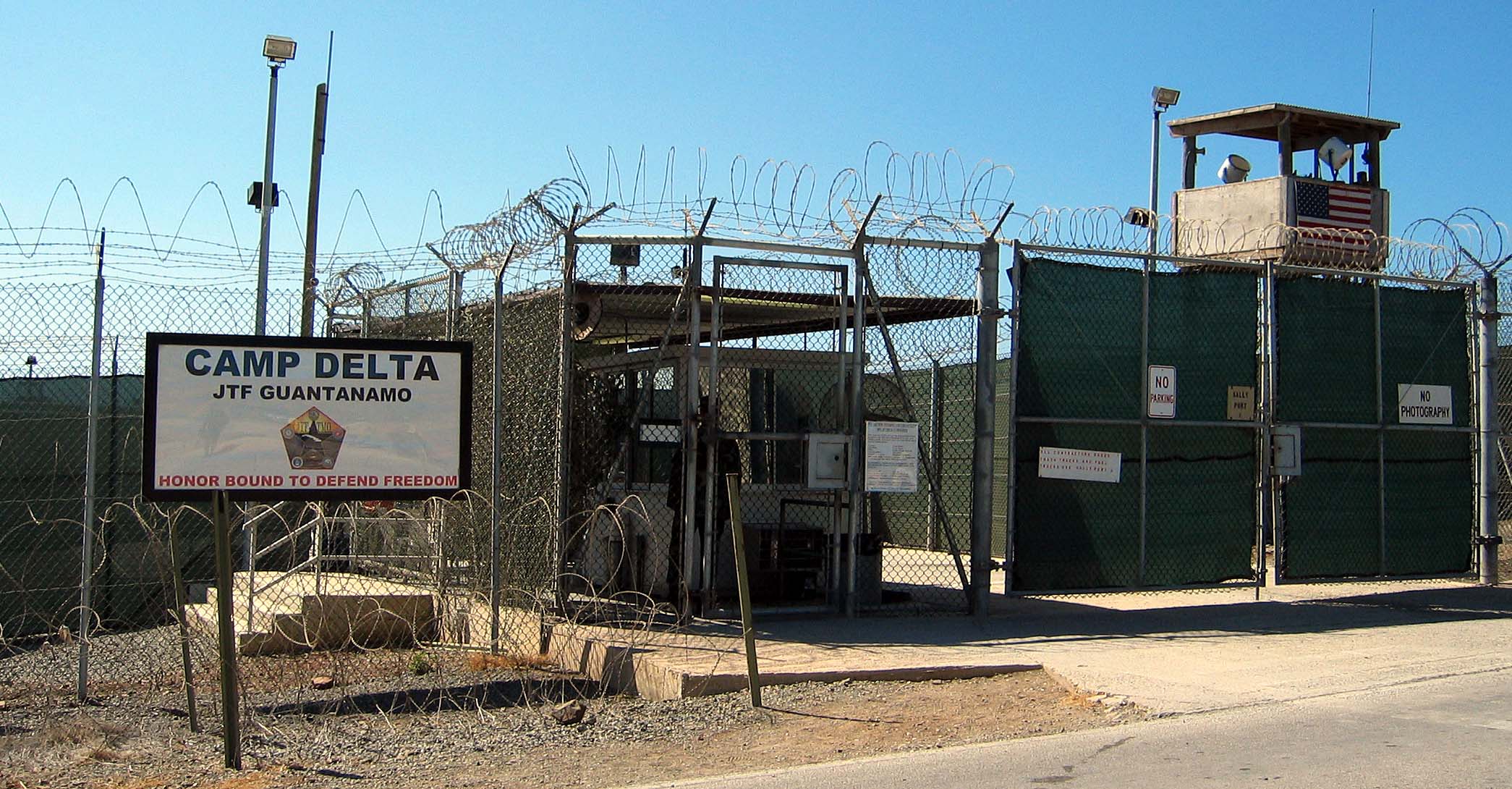Guantanamo Redux: Why It was Opened and Why It Should Be Closed (and not Enlarged)
It is hard to believe that the Guantanamo Bay detention facility is back in the headlines fifteen years after it opened and eight years after President Obama ordered it closed. Having been present at its creation in 2001/2002 and having supported its closure in 2009, I want to provide a few observations for those new to the controversy. Drawing on some of my past posts, I will remind readers why Guantanamo was opened and why I believe it should now be closed.
Why Guantanamo Bay Was Opened

Published by The Lawfare Institute
in Cooperation With

It is hard to believe that the Guantanamo Bay detention facility is back in the headlines fifteen years after it opened and eight years after President Obama ordered it closed. Having been present at its creation in 2001/2002 and having supported its closure in 2009, I want to provide a few observations for those new to the controversy. Drawing on some of my past posts, I will remind readers why Guantanamo was opened and why I believe it should now be closed.
Why Guantanamo Bay Was Opened
The Guantanamo Bay detention facility was not a political initiative of the Bush White House. It was established in early January 2002 because the Defense Department needed a secure and adequately equipped facility to hold and interrogate hundreds of Al Qaida and Taliban terror suspects who had been captured by, or turned over to, U.S. and coalition forces in Afghanistan after the invasion of Afghanistan in October 2001.
In December 2001, U.S. military commanders in Afghanistan had advised that the temporary detention facility at Kandahar air field where many suspected Taliban and Al Qaida members were being held was neither secure nor adequate as a detention and interrogation facility. (Combat operations against Taliban fighters were continuing around Kandahar into early 2002.) The commanders asked decisionmakers in Washington to find a more permanent facility with more established infrastructure where detainees could be held and questioned. At this early stage, U.S. government officials did not know who was responsible for the 9-11 attacks and feared additional terrorist attacks; a detention facility was needed where detainees could be questioned in detail about the 9-11 attacks and possible future attacks and held for prosecution by military commissions, which had been established by President Bush’s military order of November 13, 2001.
An interagency group (in which I participated) including officials from DoD, DoJ, CIA, the State Department, and the NSC staff held extensive meetings in Washington in December 2001 to consider possible options for a longer-term detention and interrogation facility. Contrary to revisionist histories written by critics of the facility, Guantanamo was not chosen primarily because it was outside the United States and not subject to the jurisdiction of U.S. courts. This was certainly one factor (DoJ and DoD lawyers did not want the detainees immediately mounting legal challenges and seeking to retain lawyers while still being questioned about further terrorist attacks), but it was not the determining factor. Other more important factors included the need to find a completely secure facility outside Afghanistan that was available immediately, convenient to the United States, relatively low-cost, and that had sufficient supporting infrastructure for both the detainees and guard force. Other locations were considered, but Guantanamo Bay—an existing Navy base on an island close to the United States that had already been used as a detention facility for thousands of Cuban refugees in the 1990s during the Clinton Administration—was the consensus option. The first detainees arrived from Kandahar on January 11, 2002.
In his June 2013 NDU speech, President Obama—echoing critics of Guantanamo—called Guantanamo “a facility that should never have been opened.” Although I came to believe by the middle of the Bush Administration that Guantanamo should be closed because it was doing more harm than good, President Obama is wrong to have asserted that the facility should never have been opened, and it was counterproductive for him to have done so if he really wanted to close it. As I have explained in this post after President Obama’s NDU speech, I am not convinced that Obama Administration officials—without the benefit of hindsight—would have made a different decision in 2001. The decision to open the detention facility in Guantanamo was not a political decision by senior Bush Administration appointees, but a practical decision based on the analysis and recommendations of career national security officials. Would the Obama Administration in 2001 have overruled military commanders and insisted that al Qaida and Taliban detainees all remain in Afghanistan? Or would they have insisted that they all be moved to the United States? Many civil liberties groups continue to insist that Taliban and Al Qaida detainees should not have been held as combatants but instead charged with federal crimes, prosecuted in federal courts, or released. But that was easier said than done: as I have explained previously, it was not immediately apparent in December 2001 that individual detainees in Kandahar had committed federal crimes or that there was admissible physical evidence and witness testimony to support federal prosecutions against them. Perhaps civil liberties groups are suggesting that, without that evidence immediately available, the detainees should have been immediately released, rather than held and questioned. To complicate matters, federal criminal law did not apply extraterritorially in 2001 to acts of material support to terrorism committed outside the United States by non-US nationals, so it is not clear whether any Taliban or al Qaida detainees could have prosecuted for federal crimes unless they had actually engaged in acts of terrorism.
President Obama blamed congressional Republicans for politicizing Guantanamo and thwarting his efforts to close it. But Democrats controlled both the House and the Senate when restrictions on closing Guantanamo were first enacted in 2009. And President Obama himself contributed heavily to the politicization of Guantanamo by pandering to his base and blaming President Bush (and impugning his motives) for opening it.
As I said in this post in January 2015:
it would be wiser for the President [Obama] to stop—once and for all—trying to score political points with Guantanamo and simply acknowledge the truth: Whatever mistakes were made in the initial creation and operation of Guantanamo, there were also understandable and legitimate military reasons to open Guantanamo in 2002 as a detention and interrogation facility after the 9/11 attacks, but the facility has outlived its comparative usefulness and its costs to U.S. national security now outweigh its remaining benefits.
Acknowledging that there were reasons to open Guantanamo in 2002 is not an endorsement of every aspect of the Guantanamo detention program. Obviously, much has been mishandled, either intentionally (like detainee abuse) or unintentionally (like the orange jump suits). Many of those initially detained in Afghanistan (like the Uighurs) should not have been sent to Guantanamo in the first place. Many of the individuals sent to Guantanamo should have been released sooner, and many officials in the Bush Administration worked hard to speed up the processes for screening and transfer or release.
Why Guantanamo Should Be Closed and No New Detainees Should Be Transferred In
As is now well-known, of the 775 detainees transferred into Guantanamo, the Bush Administration transferred more than 500 detainees out of Guantanamo between 2002-2009. Contrary to the recent statement by White House Press Secretary Sean Spicer, the vast majority of these were not transferred out pursuant to “court order.” Only a handful were transferred out of Guantanamo in December 2008 and January 2009 because of court orders after the Supreme Court decided in Boumediene v Bush that detainees should have the habeas court right to challenge their detention. In fact, the Bush Administration voluntarily transferred 532 detainees to other countries, mostly to the countries of their nationality, so that they could be prosecuted, detained, or monitored by their own governments. Although Bush Administration officials had serious concerns about recidivism, the President and his National Security Council concluded that the United States could not continue to hold hundreds of detainees indefinitely and decided that their own governments should instead take responsibility for them. As President Bush said in his memoir: “While I believe opening Guantanamo after 9/11 was necessary, the detention facility had become a propaganda tool for our enemies and a distraction for our allies. I worked to find a way to close the prison without compromising security.”
The Obama Administration transferred another 182 detainees out of Guantanamo between 2009-2017. Unlike the Bush Administration, most of these were transferred for immediate release, rather than potential continued detention and prosecution. Forty-one detainees now remain, including several who have been previously approved for transfer by an interagency review board.
Although it may be politically popular with some of the Administration’s supporters, it would be a mistake for the Trump Administration to try to repopulate Guantanamo with new detainees from the Islamic State or Al Qaida-affiliated groups, as President Trump and Attorney General Sessions have said they want to do. The Trump Administration should learn from the bitter legal and policy experiences of the Bush Administration: adding new detainees to Guantanamo will produce more (and more risky) lawsuits; difficult practical problems down the road as to what to do with the detainees; and unnecessary friction with allies. Guantanamo detainees have prevailed in numerous challenges to their detention in federal courts (including four cases before the Supreme Court). Any new ISIS detainees in Guantanamo would undoubtedly claim in habeas petitions that the 2001 AUMF does not authorize their detention because it is limited to the organizations responsible for the 9-11 attacks. As Jack Goldsmith has pointed out, “it is easy to imagine a habeas court ruling that the President does not have the authority to detain a member of ISIL because the 2001 AUMF does not extend to ISIL.” And as I explained in my Lloyd Cutler lecture last fall, our allies are likely to cut back on intelligence, law enforcement, and military cooperation if they believe the United States is not acting consistent with international law and our shared democratic values.
President Trump and Attorney General Sessions should instead consider a “Nixon to China” policy of seeking legislation that would allow the President to close Guantanamo and transfer the remaining detainees to their own governments and to one or more military and/or federal detention facilities in the United States for continued detention and potential prosecution. It is highly unlikely that any detainee could escape from a maximum security prison in the United States. Although it is possible that detainees held in the United States could bring additional legal challenges to their detention, detainees have already been successful in legal challenges while detained in Guantanamo; it will be difficult for the remaining detainees who have not been cleared for release to persuade a federal court that they should be released or given immigration rights. President Trump, Attorney General Sessions, Secretaries Mattis and Kelly, CIA Director Pompeo and DNI-designate Coats should consult with the experienced lawyers and policy experts in their departments about the risks of costs and benefits of Guantanamo. They are likely to find that repopulating Guantanamo will produce more costs and risks than benefits and that it would be both preferable, and possible, to achieve President Bush’s goal of closing Guantanamo without compromising security.





